Simulation Study on Solar Single/Double-Effect Switching LiBr-H2O Absorption Refrigeration System
Abstract
1. Introduction
2. System Description
3. Models and Methods
3.1. Model of Solar Heat Collection System
3.2. Model of Absorption Refrigeration System
- The internal pressure drop of each component of the system is negligible;
- Throttling devices are adiabatic;
- The low pressure generator and the condenser have the same pressure, the absorber and evaporator have the same pressure;
- The power of the solution pump is negligible.
3.3. Performance Evaluation
4. Results and Discussion
4.1. System Operation Performance
4.1.1. Analysis of System Operation without Auxiliary Heater
4.1.2. Analysis of System Operation with Auxiliary Heater
4.1.3. Analysis of System Operation in the Whole Refrigeration Season
4.2. Economic Analysis
4.3. Environmental Analysis
5. Conclusions
Author Contributions
Funding
Data Availability Statement
Conflicts of Interest
Nomenclature
| area (m2) | |
| c | unit cost of natural gas (CNY·m−3) |
| CO2 emissions (kg) | |
| capital investment cost (CNY) | |
| installation cost (CNY) | |
| COP | coefficient of performance (–) |
| specific heat at constant pressure (kJ·kg−1·°C−1) | |
| capital recovery factor (–) | |
| total cost (CNY) | |
| fuel cost (CNY) | |
| primary energy saving rate (–) | |
| enthalpy (kJ·kg−1) | |
| interest rate (%) | |
| heat transfer coefficient (W·m−2·°C−1) | |
| mass flow rate (kg·s−1) | |
| n | system lifetime (year) |
| heat exchange efficiency | |
| latent heat of vaporization (kJ·kg−1) | |
| heat transfer rate (kW) | |
| cooling capacity (kW) | |
| solar fraction | |
| T | temperature (°C) |
| volume (m3) | |
| x | solution mass fraction |
| Z | purchased equipment cost (CNY) |
| Subscripts | |
| ARS | absorption refrigeration system |
| AB,ab | absorber |
| aux | auxiliary |
| awi | cooling water inlet |
| c | collector |
| cho | chilled water outlet |
| CHW | chilled water |
| CON | condenser |
| CW | cooling water |
| DACH | double-effect absorption chiller |
| DEM | double-effect mode |
| d | double-effect |
| EVA,e | evaporator |
| E | electric |
| EV | electric valve |
| f | fuel |
| GEN,g | generator |
| HG,hg | high pressure generator |
| HW | hot water |
| hwi | hot water inlet |
| i | set-point |
| in | input |
| L | levelized |
| LG,lg | low pressure generator |
| NG | natural gas |
| out | output |
| p | pump |
| s | single-effect |
| SACH | single-effect absorption chiller |
| SEM | single-effect mode |
| SC | solar collector |
| ST,st | storage tank |
| v | vapor |
References
- Rodriguez-Toscano, A.; Amaris, C.; Sagastume-Gutierrez, A.; Bourouis, M. Technical, environmental, and economic evaluation of a solar/gas driven absorption chiller for shopping malls in the Caribbean region of Colombia. Case Stud. Therm. Eng. 2022, 30, 101743. [Google Scholar] [CrossRef]
- Alobaid, M.; Hughes, B.; Calautit, J.K.; O’Connor, D.; Heyes, A. A review of solar driven absorption cooling with photovoltaic thermal systems. Renew. Sustain. Energy Rev. 2017, 76, 728–742. [Google Scholar] [CrossRef]
- Mortadi, M.; El Fadar, A. Performance, economic and environmental assessment of solar cooling systems under various climates. Energ. Convers. Manag. 2022, 252, 114993. [Google Scholar] [CrossRef]
- Ayou, D.S.; Coronas, A. New Developments and Progress in Absorption Chillers for Solar Cooling Applications. Appl. Sci. 2020, 10, 4073. [Google Scholar] [CrossRef]
- Aliane, A.; Abboudi, S.; Seladji, C.; Guendouz, B. An illustrated review on solar absorption cooling experimental studies. Renew. Sustain. Energy Rev. 2016, 65, 443–458. [Google Scholar] [CrossRef]
- Barbosa, J.M.; Andrade, L.A.; Vieira, L.G.M.; Barrozo, M.A.S. Multi-response optimization of bio-oil production from catalytic solar pyrolysis of Spirulina platensis. J. Energy Inst. 2020, 93, 1313–1323. [Google Scholar] [CrossRef]
- Bataineh, K.M.; Alrifai, S. Recent trends in solar thermal sorption cooling system technology. Adv. Mech. Eng. 2015, 7, 1687814015586120. [Google Scholar] [CrossRef]
- Cerezo, J.; Lara, F.; Romero, R.J.; Rodriguez, A. Analysis and Simulation of an Absorption Cooling System Using a Latent Heat Storage Tank and a Tempering Valve. Energies 2021, 14, 1376. [Google Scholar] [CrossRef]
- Xu, Z.Y.; Wang, R.Z. Simulation of solar cooling system based on variable effect LiBr-water absorption chiller. Renew. Energy 2017, 113, 907–914. [Google Scholar] [CrossRef]
- Figaj, R.; Zoladek, M. Experimental and numerical analysis of hybrid solar heating and cooling system for a residential user. Renew. Energy 2021, 172, 955–967. [Google Scholar] [CrossRef]
- Chen, L.; Jin, S.M.; Bu, G.F. Experimental investigation of a novel multi-tank thermal energy storage system for solar-powered air conditioning. Appl. Therm. Eng. 2017, 123, 953–962. [Google Scholar] [CrossRef]
- Singh, G.; Das, R. Experimental Study on a New Small-Scale Absorption System: Response Surface and Inverse Analyses. J. Energ. Resour. Technol. 2021, 143, 092103. [Google Scholar] [CrossRef]
- Shirazi, A.; Taylor, R.A.; Morrison, G.L.; White, S.D. Solar-powered absorption chillers: A comprehensive and critical review. Energ. Convers. Manag. 2018, 171, 59–81. [Google Scholar] [CrossRef]
- Sun, S.; Zhang, K.; Song, Q.; Wang, D.; Li, Y.; Kong, X. Experimental research on heat and mass transfer characteristics of membrane energy accumulator used in solar refrigeration. Int. J. Refrig. 2021, 128, 186–196. [Google Scholar] [CrossRef]
- Sun, S.; Sun, H.; Song, Q.; Wang, D.; Kong, X.; Li, Y. Comparative analysis of energy discharge characteristics between hollow fiber membrane and flat membrane energy accumulators. Int. J. Refrig. 2021, 131, 874–886. [Google Scholar] [CrossRef]
- Iranmanesh, A.; Mehrabian, M.A. Dynamic simulation of a single-effect LiBr–H2O absorption refrigeration cycle considering the effects of thermal masses. Energ. Build. 2013, 60, 47–59. [Google Scholar] [CrossRef]
- Cheng, Y.L.; Liu, M.; Liu, Z.D.; Zhan, C.L. Operation analysis and optimization study of a small absorption refrigeration system driven by flat plate collector. Renew. Energy Resour. 2021, 41, 1023–1029. [Google Scholar]
- Shirazi, A.; Taylor, R.A.; White, S.D.; Morrison, G.L. A systematic parametric study and feasibility assessment of solar-assisted single-effect, double-effect, and triple-effect absorption chillers for heating and cooling applications. Energ. Convers. Manag. 2016, 114, 258–277. [Google Scholar] [CrossRef]
- Siddique, M.Z.; Badar, A.W.; Siddiqui, M.S.; Butt, F.S.; Saleem, M.; Mahmood, K.; Fazal, I. Performance analysis of double effect solar absorption cooling system with different schemes of hot/cold auxiliary integration and parallel-serial arrangement of solar field. Energy 2022, 245, 123299. [Google Scholar] [CrossRef]
- Hang, Y.; Qu, M.; Winston, R.; Jiang, L.; Widyolar, B.; Poiry, H. Experimental based energy performance analysis and life cycle assessment for solar absorption cooling system at University of Californian, Merced. Energ. Build. 2014, 82, 746–757. [Google Scholar] [CrossRef]
- Rahman, S.; Said, Z.; Issa, S. Performance evaluation and life cycle analysis of new solar thermal absorption air conditioning system. Energy Rep. 2020, 6, 673–679. [Google Scholar] [CrossRef]
- Narayanan, R.; Harilal, G.K.; Golder, S. Feasibility study on the solar absorption cooling system for a residential complex in the Australian subtropical region. Case Stud. Eng. 2021, 27, 101202. [Google Scholar] [CrossRef]
- Figaj, R.; Szubel, M.; Przenzak, E.; Filipowicz, M. Feasibility of a small-scale hybrid dish/flat-plate solar collector system as a heat source for an absorption cooling unit. Appl. Therm. Eng. 2019, 163, 114399. [Google Scholar] [CrossRef]
- Xu, Z.Y.; Wang, R.Z. Comparison of CPC driven solar absorption cooling systems with single, double and variable effect absorption chillers. Sol. Energy 2017, 158, 511–519. [Google Scholar] [CrossRef]
- Zhang, K.; Ma, H.; Li, Q.; Wang, D.; Song, Q.; Wang, X.; Kong, X. Thermodynamic analysis and optimization of variable effect absorption refrigeration system using multi-island genetic algorithm. Energy Rep. 2022, 8, 5443–5454. [Google Scholar] [CrossRef]
- Ke, Z.; Haijing, M.; Honglei, S.; Dechang, W.; Xiaohe, W.; Qinglu, S. Parameter Evaluation of Variable Effect Lithium Bromide Absorption Refrigeration Cycles Based on ANOVA. J. Refrig. 2022, 43, 137–144. [Google Scholar] [CrossRef]
- Lubis, A.; Jeong, J.; Giannetti, N.; Yamaguchi, S.; Saito, K.; Yabase, H.; Alhamid, M.I.; Nasruddin. Operation performance enhancement of single-double-effect absorption chiller. Appl. Energy 2018, 219, 299–311. [Google Scholar] [CrossRef]
- Alhamid, M.I.; Coronas, A.; Lubis, A.; Ayou, D.S.; Nasruddin; Saito, K.; Yabase, H. Operation strategy of a solar-gas fired single/double effect absorption chiller for space cooling in Indonesia. Appl. Therm. Eng. 2020, 178, 115524. [Google Scholar] [CrossRef]
- Ma, H.; Li, Q.; Wang, D.; Song, Q.; Zhou, S.; Wang, X.; Li, Y. Operating performance and economic analysis of solar single/double-effect compound absorption refrigeration system. Sol. Energy 2022, 247, 73–85. [Google Scholar] [CrossRef]
- Qing, C. Analysis of Operating Characteristics of Solar Lithium Bromide Absorption Unit; North China Electric Power University: Qingdao, China, 2020. [Google Scholar] [CrossRef]
- Ibrahim, N.I.; Al-Sulaiman, F.A.; Ani, F.N. A detailed parametric study of a solar driven double-effect absorption chiller under various solar radiation data. J. Clean Prod. 2020, 251, 119750. [Google Scholar] [CrossRef]
- Rejeb, O.; Ghenai, C.; Bettayeb, M. Modeling and simulation analysis of solar absorption chiller driven by nanofluid-based parabolic trough collectors (PTC) under hot climatic conditions. Case Stud. Eng. 2020, 19, 100624. [Google Scholar] [CrossRef]
- Wageiallah Mohammed, O.; Yanling, G. Comprehensive Parametric Study of a Solar Absorption Refrigeration System to Lower Its Cut In/Off Temperature. Energies 2017, 10, 1746. [Google Scholar] [CrossRef]
- Bagheri, B.S.; Shirmohammadi, R.; Mahmoudi, S.M.S.; Rosen, M.A. Optimization and comprehensive exergy-based analyses of a parallel flow double-effect water-lithium bromide absorption refrigeration system. Appl. Therm. Eng. 2019, 152, 643–653. [Google Scholar] [CrossRef]
- Abrudan, A.C.; Pop, O.G.; Serban, A.; Balan, M.C. New Perspective on Performances and Limits of Solar Fresh Air Cooling in Different Climatic Conditions. Energies 2019, 12, 2113. [Google Scholar] [CrossRef]
- Mehmood, S.; Maximov, S.A.; Chalmers, H.; Friedrich, D. Energetic, Economic and Environmental (3E) Assessment and Design of Solar-Powered HVAC Systems in Pakistan. Energies 2020, 13, 4333. [Google Scholar] [CrossRef]
- Esfandi, S.; Baloochzadeh, S.; Asayesh, M.; Ehyaei, M.A.; Ahmadi, A.; Rabanian, A.A.; Das, B.; Costa, V.A.F.; Davarpanah, A. Energy, Exergy, Economic, and Exergoenvironmental Analyses of a Novel Hybrid System to Produce Electricity, Cooling, and Syngas. Energies 2020, 13, 6453. [Google Scholar] [CrossRef]
- Sadi, M.; Arabkoohsar, A. Exergy, economic and environmental analysis of a solar-assisted cold supply machine for district energy systems. Energy 2020, 206, 118210. [Google Scholar] [CrossRef]
- Liu, L.; Li, Z.; Jing, Y.; Lv, S. Energetic, economic and environmental study of cooling capacity for absorption subsystem in solar absorption-subcooled compression hybrid cooling system based on data of entire working period. Energ. Convers. Manag. 2018, 167, 165–175. [Google Scholar] [CrossRef]
- Shirazi, A.; Taylor, R.A.; White, S.D.; Morrison, G.L. Transient simulation and parametric study of solar-assisted heating and cooling absorption systems: An energetic, economic and environmental (3E) assessment. Renew. Energy 2016, 86, 955–971. [Google Scholar] [CrossRef]
- Li, J.; Yao, Y.; Liu, B. Optimization operation of comprehensive energy system based on comprehensive evaluation index. J. Guangxi Univ. Nat. Sci. Ed. 2022, 47, 1518–1531. [Google Scholar] [CrossRef]
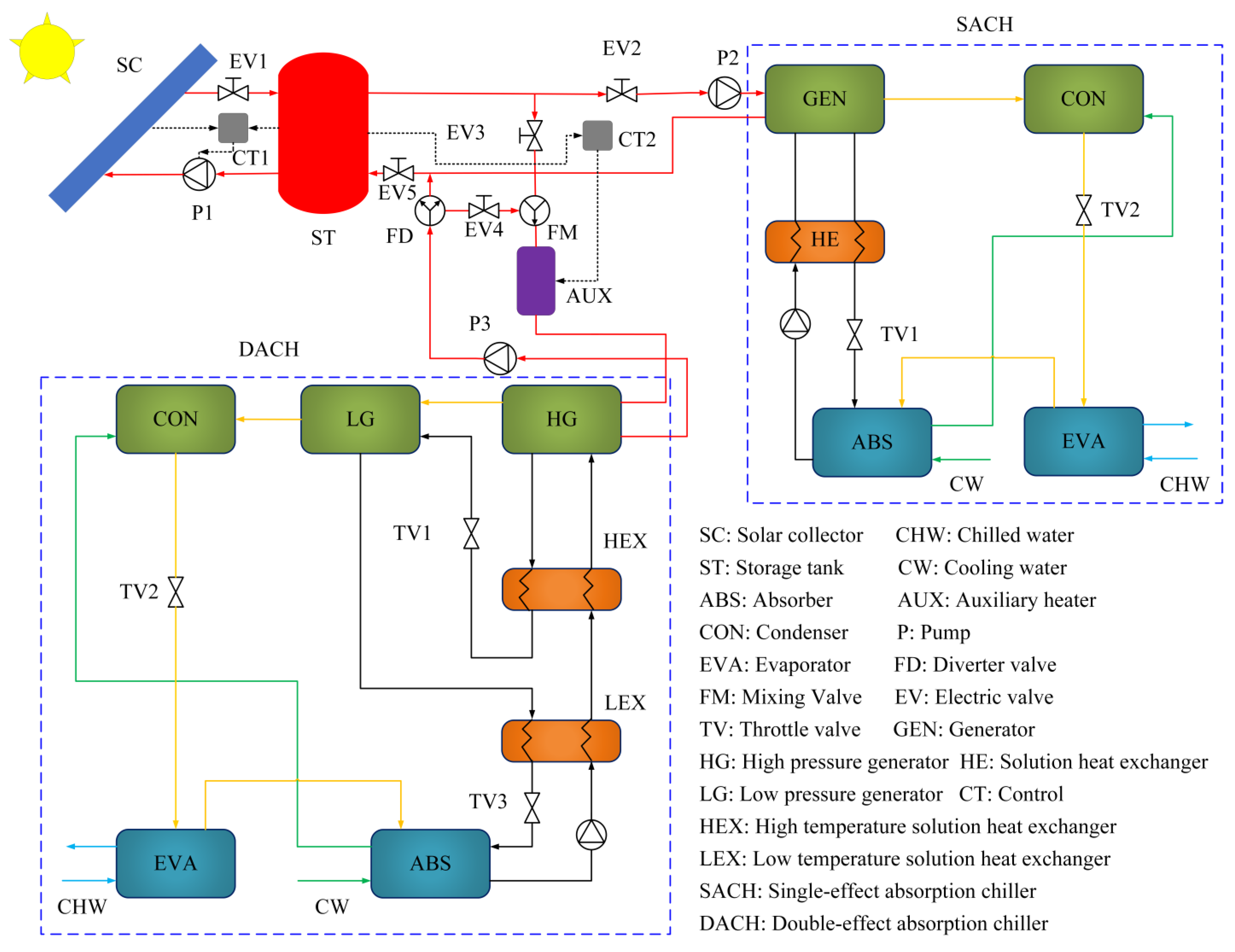


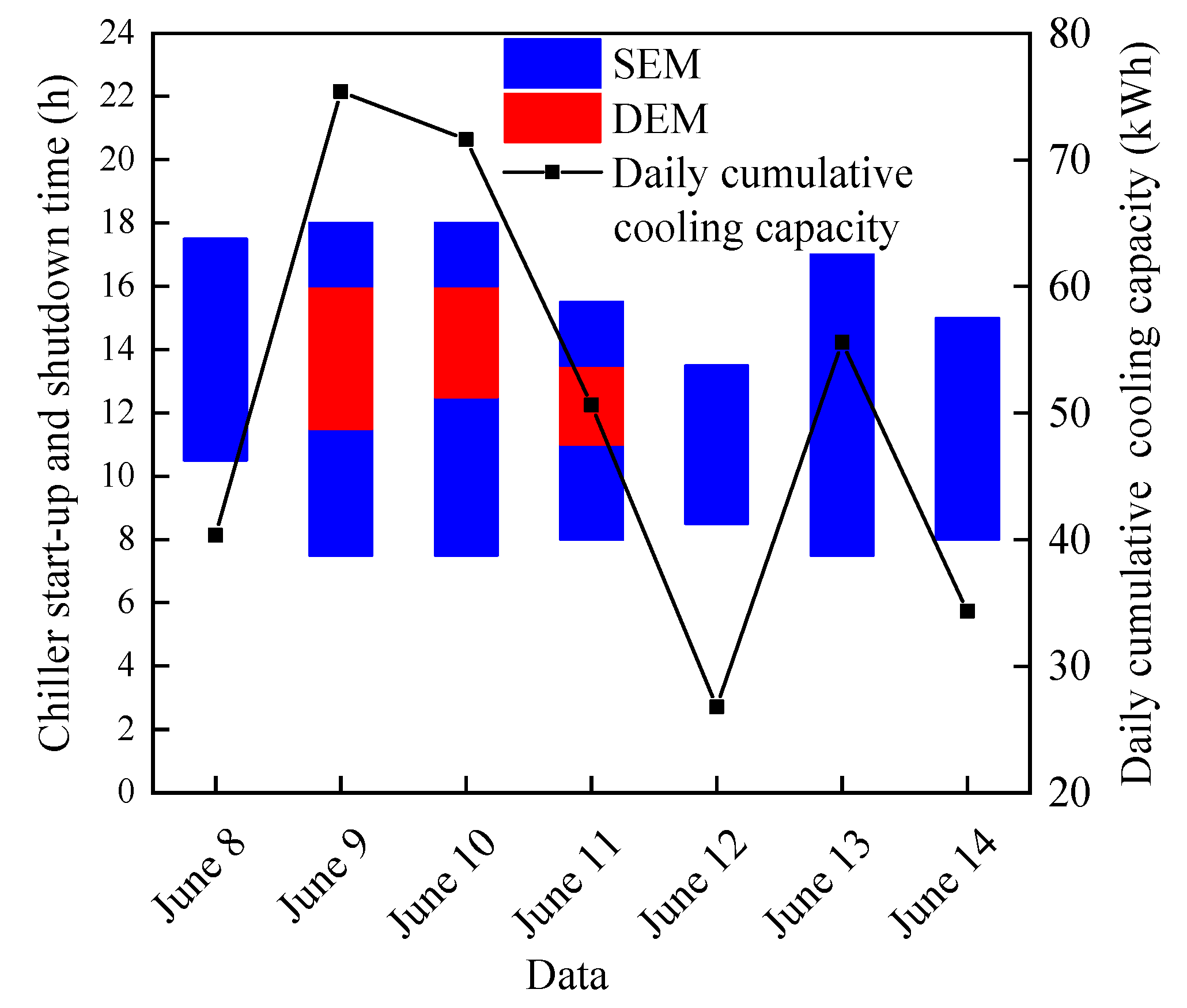
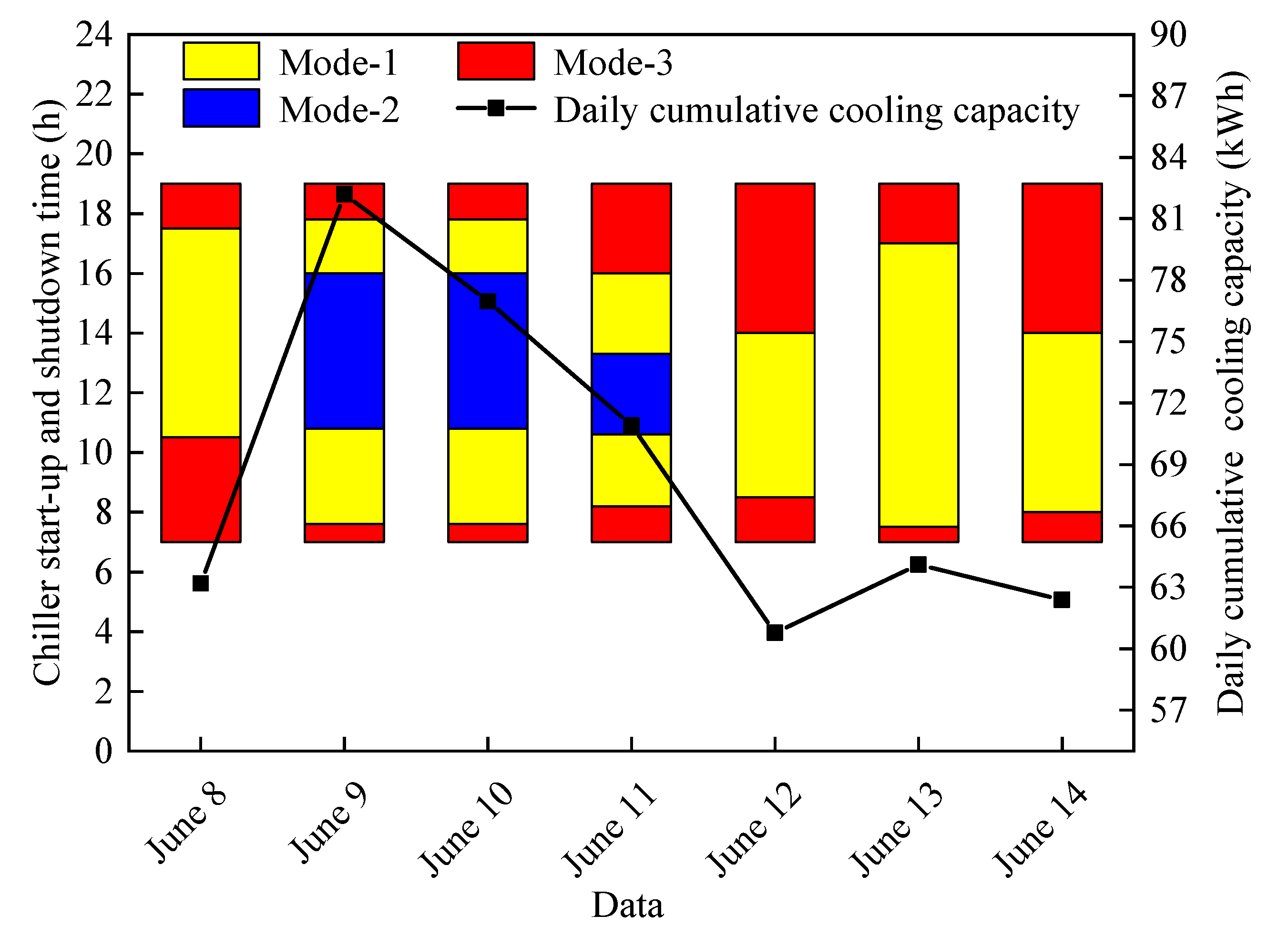
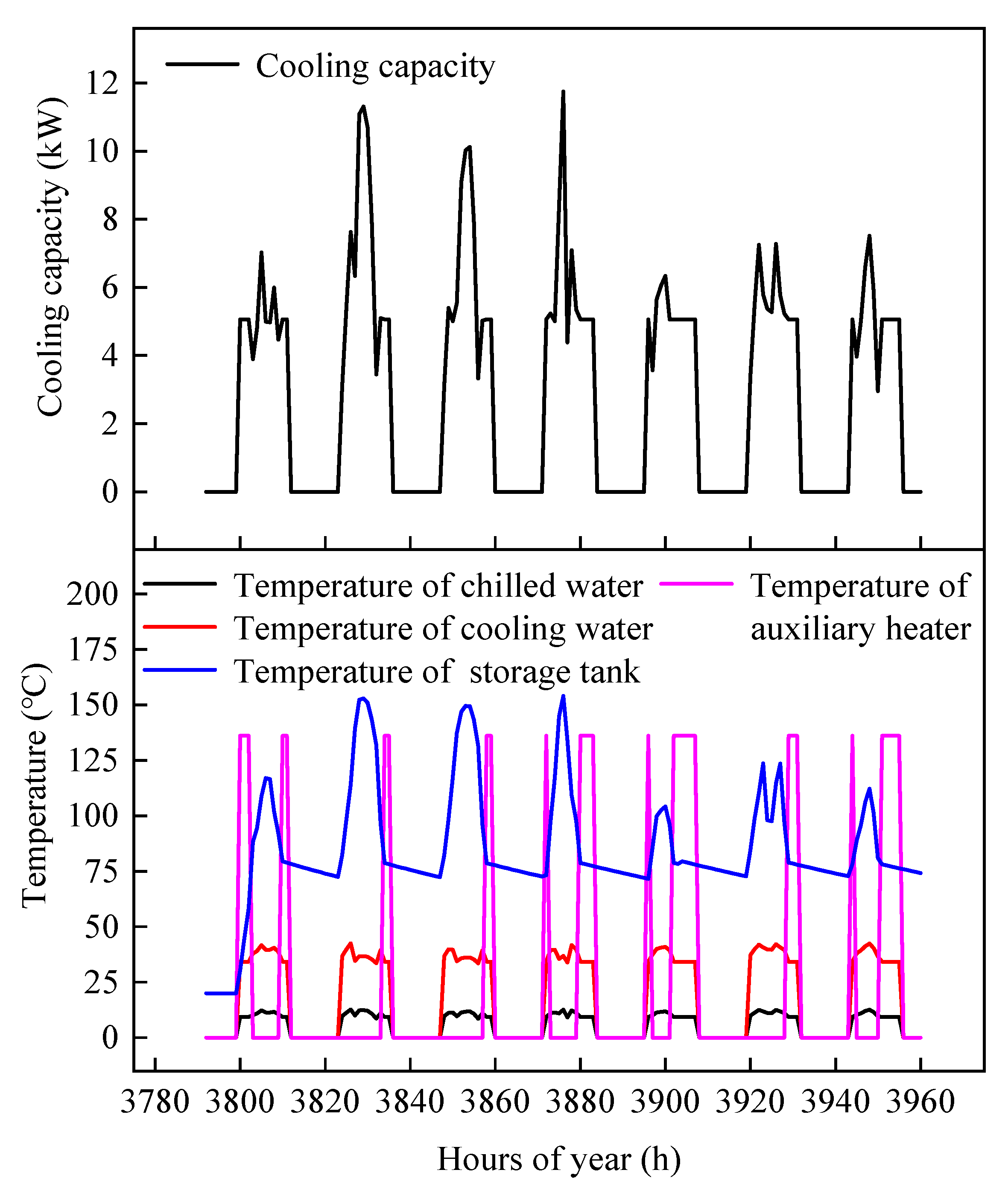
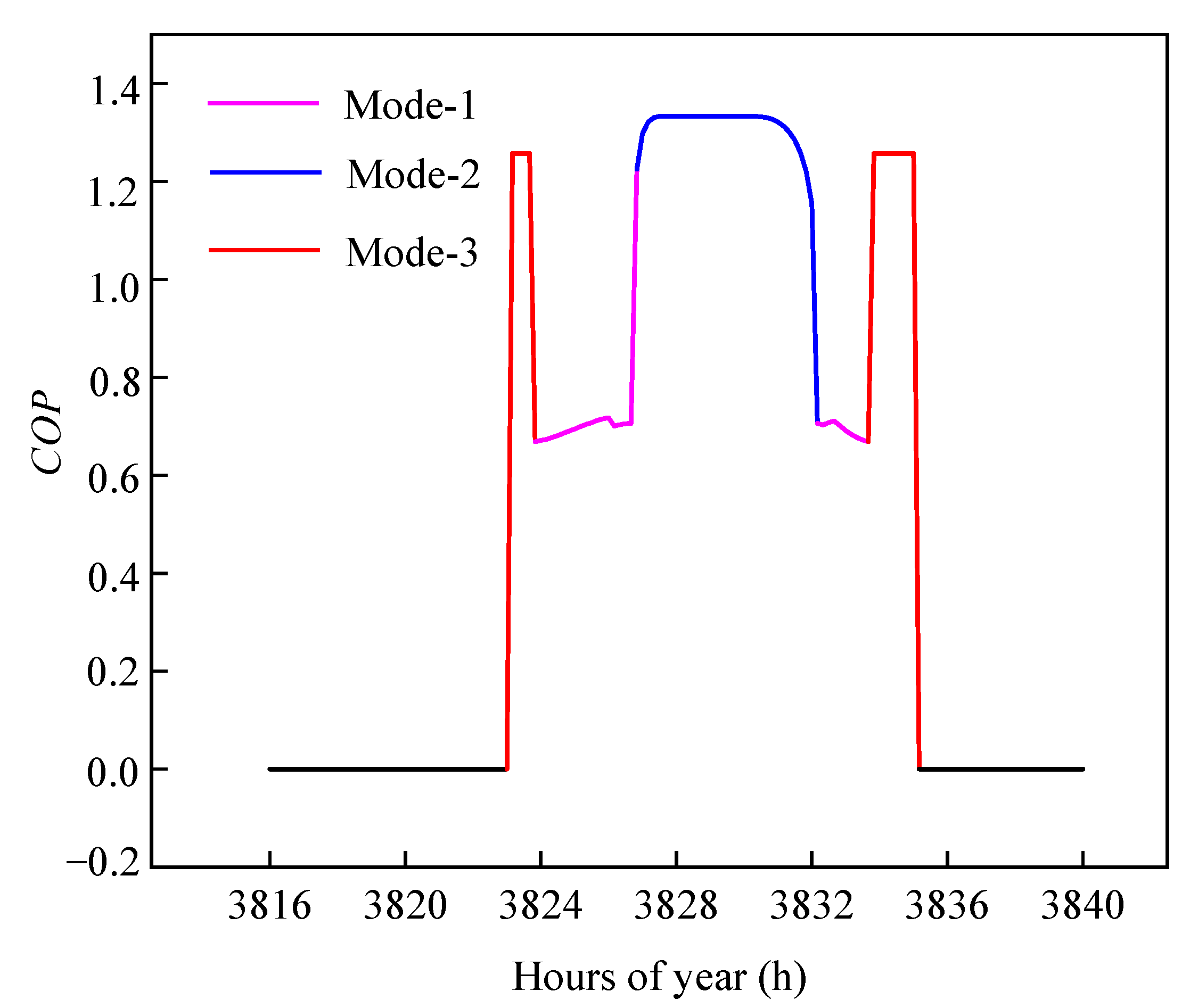
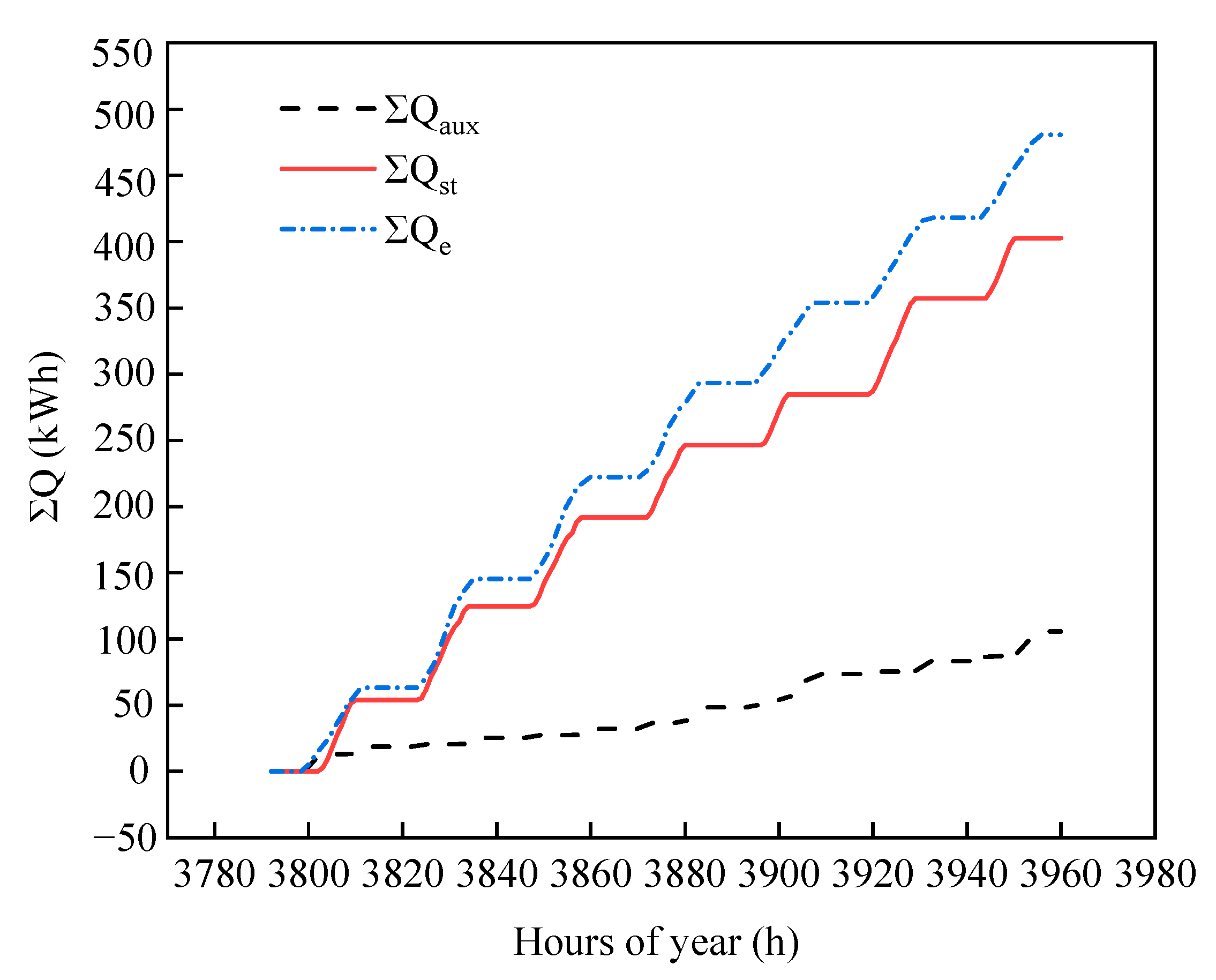
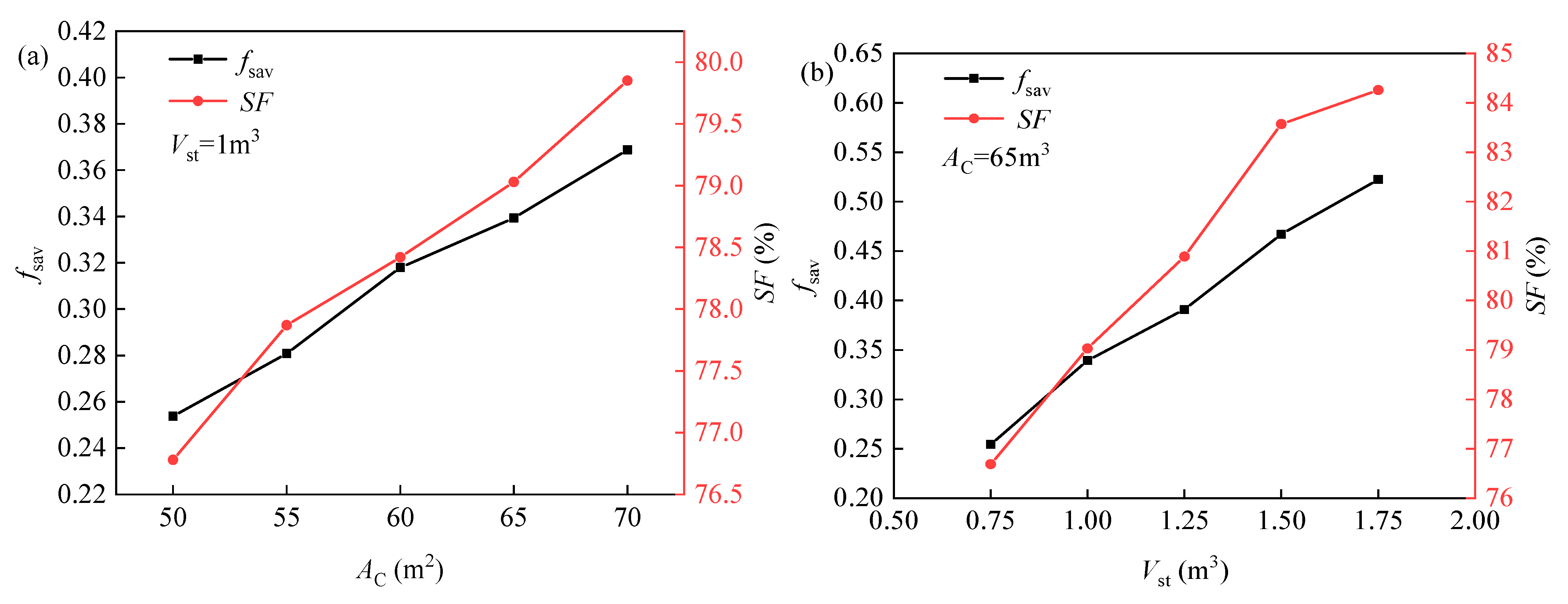

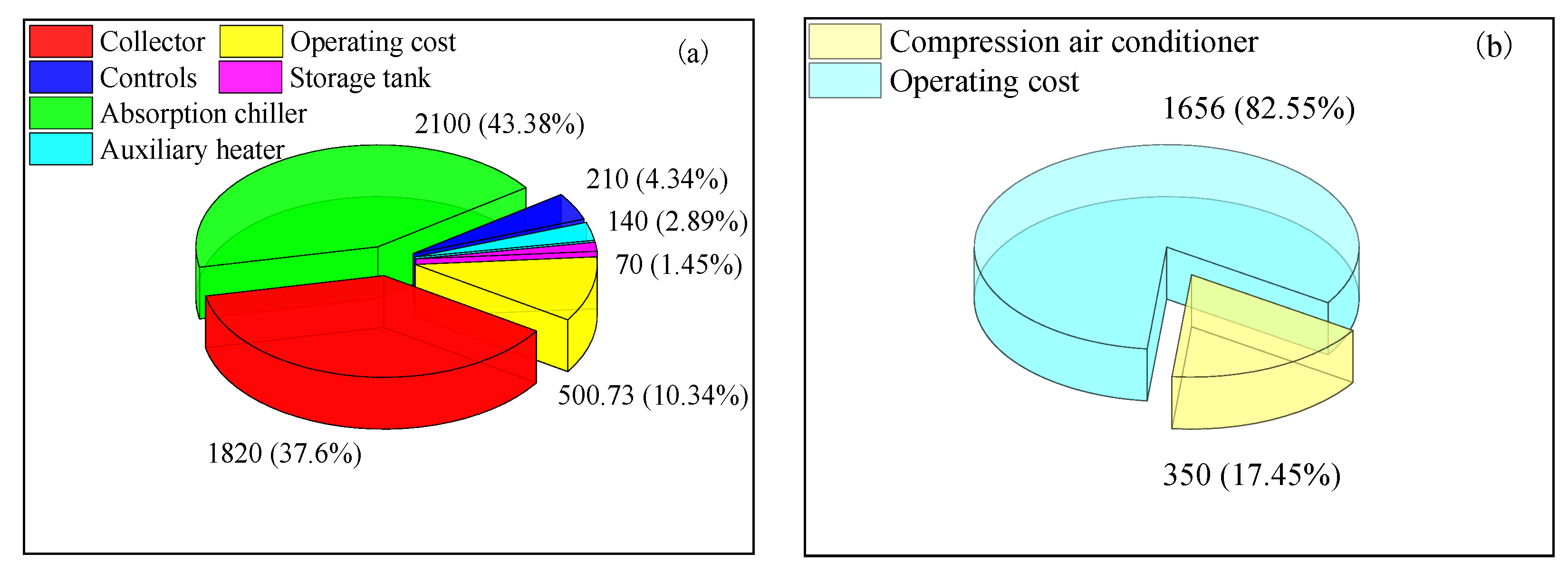

| Parameter | Unit | Value |
|---|---|---|
| Absorption chiller | CNY·kW−1 | 2000 |
| Compression air conditioner | CNY·kW−1 | 1000 |
| Controllers | CNY | 3000 |
| Auxiliary heater | CNY | 2000 |
| Storage tank | CNY·m−3 | 1000 |
| Solar collector | CNY·m−2 | 400 |
| Natural gas price | CNY·m−3 | 3 |
| Electricity price | CNY·kWh−1 | 1 |
| Interest rate | % | 4.9 |
| System lifetime | years | 25 |
| Parameter | Unit | Value |
|---|---|---|
| Single-effect rated cooling capacity | kW | 5 |
| Double-effect rated cooling capacity | kW | 10 |
| Tank volume | m3 | 1 |
| Collector area | m2 | 65 |
| Collector slope | ° | 45 |
| Longitude of Qingdao | °E | 120.5 |
| Latitude of Qingdao | °N | 35.8 |
| Parameter | Unit | Value |
|---|---|---|
| kg·s−1 | 0.83 | |
| kg·s−1 | 0.3 | |
| °C | 32 | |
| kg·s−1 | 0.4 | |
| °C | 7 | |
| kg·s−1 | 0.3 | |
| kg·s−1 | 0.5 | |
| °C | 32 | |
| kg·s−1 | 1 | |
| °C | 7 | |
| kg·s−1 | 0.5 |
Disclaimer/Publisher’s Note: The statements, opinions and data contained in all publications are solely those of the individual author(s) and contributor(s) and not of MDPI and/or the editor(s). MDPI and/or the editor(s) disclaim responsibility for any injury to people or property resulting from any ideas, methods, instructions or products referred to in the content. |
© 2023 by the authors. Licensee MDPI, Basel, Switzerland. This article is an open access article distributed under the terms and conditions of the Creative Commons Attribution (CC BY) license (https://creativecommons.org/licenses/by/4.0/).
Share and Cite
Li, Q.; Zhao, S.; Wang, D.; Song, Q.; Zhou, S.; Wang, X.; Li, Y. Simulation Study on Solar Single/Double-Effect Switching LiBr-H2O Absorption Refrigeration System. Energies 2023, 16, 3220. https://doi.org/10.3390/en16073220
Li Q, Zhao S, Wang D, Song Q, Zhou S, Wang X, Li Y. Simulation Study on Solar Single/Double-Effect Switching LiBr-H2O Absorption Refrigeration System. Energies. 2023; 16(7):3220. https://doi.org/10.3390/en16073220
Chicago/Turabian StyleLi, Qingyang, Shiqi Zhao, Dechang Wang, Qinglu Song, Sai Zhou, Xiaohe Wang, and Yanhui Li. 2023. "Simulation Study on Solar Single/Double-Effect Switching LiBr-H2O Absorption Refrigeration System" Energies 16, no. 7: 3220. https://doi.org/10.3390/en16073220
APA StyleLi, Q., Zhao, S., Wang, D., Song, Q., Zhou, S., Wang, X., & Li, Y. (2023). Simulation Study on Solar Single/Double-Effect Switching LiBr-H2O Absorption Refrigeration System. Energies, 16(7), 3220. https://doi.org/10.3390/en16073220





